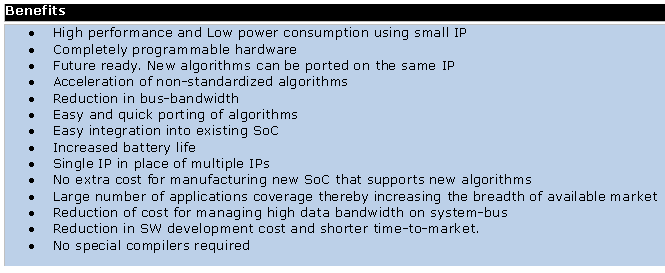
Most high resolution and high definition devices are based on multimedia computing., which require stringent performance and high computational power at the same time. Now the problem is that in the process of getting high computational power, high energy is consumed. The Universal Multifunction Accelerator design tackles this issue.
It consumes ultra low power and at the same time enables high performance computing compared to software approach, benefiting the low end devices. It also has a capability to be used with various types of applications without the requirement of any new tool or infrastructure.
The main purpose of creating UMA was to address the common problem in mobile IC (Integrated Circuits).
The common challenge with mobile IC was to get the quickest way to process data on silicon, while keeping within an allowable range of minimum power consumption with proper flexibility during any change in data standards. Thus we can define UMA as a practical algorithm and architecture for mobile manufacturers and users. Currently, the processors that exist are hardwired and the major demerit that they have is that once set with an algorithm, they cannot be re-programmed.
On the other hand, UMA has been designed to support new algorithms as well and can play videos with high resolution and memory without any error. It does not require any special compiler or infrastructure for it’s operation. It is based on Middle Stratum Operations (MSO) for any computation where MSO is a new, patent pending computing method.
Existing hardware accelerators
Generally speaking, the market today has no multifunction accelerators (Universal Multifunction Accelerator or UMA). The only types of approaches followed to accelerate audio/video/image processing are- Hardware accelerators and Multi-core CPUs with or without SIMD or VLIW coprocessor extensions or DSPs or GPUs.
Hardware accelerators are the circuits for computing specific algorithms. They provide very high performance and low power consumption. They are used for computing standardized video algorithms (ex. video decompression) and some image processing algorithms. However, they too have drawbacks like they cannot be re-programmed and have huge gate count (Silicon area).
Whereas multi-core CPUs (Central Processing Units) with or without SIMD (Single instruction, multiple data) or VLIW (Very Long Instruction Word) coprocessor extensions, DSPs (Digital Signal Processors), GPUs (Graphical Processing Units) etc., are programmable solutions. These are primarily used for audio processing, but not so much for video.
Although they can be re-programmed, their performance (acceleration) is low and consume high power. Some times such programmable solutions are used for certain computationally intensive image processing/computer vision algorithms despite the above drawback owing to the necessity of programmability.
This newly developed hardware accelerator is a small gate count circuit which not only overcomes the issues with the existing hardware but also forms the sole solution for high end performance of all mobile devices.

Features and Benefits of UMA
The features of a Universal Multifunction Accelerator are based on Middle Stratum Operation owing to the fact that it follows MSO computation. All it’s computations are on local memory that eliminates the system bus latency thus seeding up the operation. MSOs are run time configurable that makes them ready for future operations. They cover all the algorithms in one application which provides full flexibility of control flow in CPU.

These features of UMA make us focus on it’s benefits. Because of it’s MSO computation it provides high performance, consuming low power, using just a small IP. It allows easy porting of the algorithms and easy integration into the existing System on Chip thus enabling it’s architecture useful in all types of application. It forms a valuable device for the customers providing them an increased battery life of the appliance.

Demand for high quality multimedia applications on portable devices like mobile phones, tablets, personal entertainment devices is constantly increasing. Mobile shipment market alone is expected to touch 16 billion by 2016. These applications involve heavy computations constituting a heavy load on the processors inside these devices. There is huge market for processors of these devices today and UMA can become the role model of this market.
You may also like: click here
Sneha Ambastha is technical journalist at EFY Gurgaon








